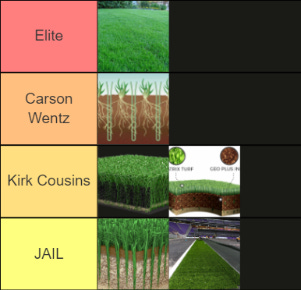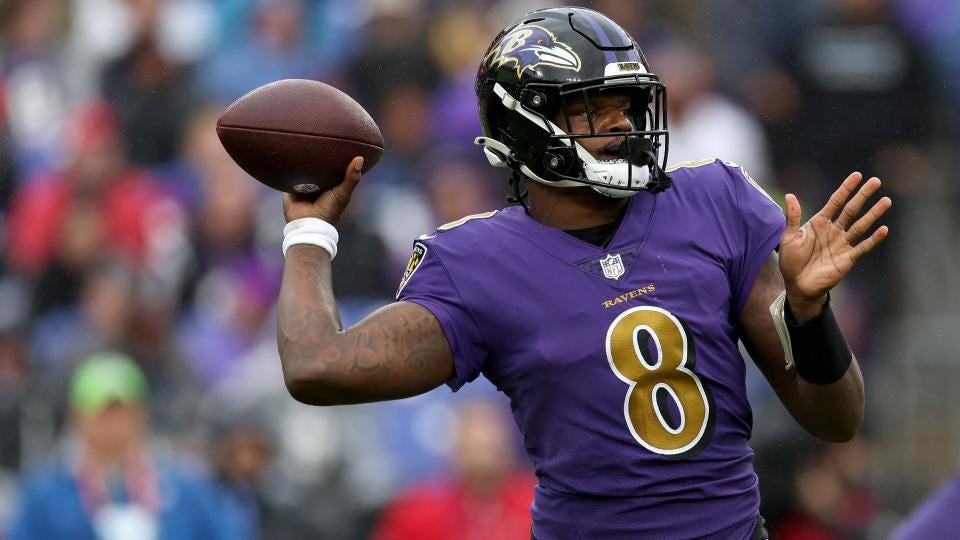This week we’ll be touching grass discussing the various types of turf used by NFL stadiums and their impacts on player health.
Types of grass:
Astroturf
While Astroturf has become synonymous with artificial grass products in general, it is actually a company. Astroturf was first invented in 1965 by Monsanto (of course), and AstroTurf Inc. has gone through various stints as both subsidiary company and standalone firm since then. As of 2016 it is owned by SportGroup Holding, a German company. Their main product is a nylon-fiber artificial grass which has “infill materials” (crumb rubber) as shock absorbers/simulated dirt woven between the nylon.
Use in NFL stadiums:
Buffalo (Highmark Stadium), Kansas City (Arrowhead Stadium), New Orleans (formerly, Mercedes-Benz Superdome), St. Louis (formerly, Edward Jones Dome)
Matrixturf
Matrixturf is another synthetic grass company. I can’t find a whole lot of the specifics for how it is made but their marketing materials suggest their product is a “multi-layer system” which imitates human muscle-fibers to allow for better shock absorption and bounce-back.
Use in NFL stadiums:
Dallas (AT&T Stadium), Houston (NRG Stadium), LA/LAC (SoFi Stadium)
Sportturf
The most advanced product offering from UBU Sports, it was debuted at the Vikings stadium in 2016. Again, don’t know a lot about the grass itself, but the company says that it “maximizes player safety”. Notice how real grass companies don’t have to make that same promise..
Use in NFL stadiums:
Minnesota (US Bank Stadium)
Fieldturf
Fake grass made from polyethylene, with silica sand and rubber to simulate dirt and absorb shocks.
Use in NFL stadiums:
Seattle (Lumen Field), Atlanta (Georgia Dome, then Mercedes-Benz Stadium), Detroit (Ford Field), Cincinnati (Paycor Stadium), Indianapolis (Lucas Oil Stadium), New England (Gillette Stadium), New York Jets/Giants (MetLife Stadium)
Real grass
There are a lot of different types of grass, believe me. The most commonly used seems to be Kentucky Bluegrass, though:
Use in NFL stadiums: basically everyone else
Denver (Mile High Stadium), Arizona (State Farm Stadium), Baltimore (M&T Bank Stadium), Carolina (Bank of America Stadium), Chicago (Soldier Field), Cleveland (FirstEnergy Stadium), Green Bay (Lambeau Field), Jacksonville (TIAA Bank Stadium), Las Vegas (Allegiant Stadium), Miami (Hard Rock Stadium), Oakland (formerly, Oakland-Alameda County Coliseum), Philadelphia (Lincoln Financial Field), Pittsburgh (Acrisure Stadium), San Diego (formerly, Qualcomm Stadium), San Francisco (Levi’s Stadium), Tampa Bay (Raymond James Stadium), Tennessee (Nissan Field), Washington (FedEx Field)
Dessograss
???? Apparently they have android hybrid-grass which is half real grass, half synthetic grass. The real grass grows around the synthetic fibers, forming a surface which has the durability of synthetic turf but the feel of real grass. Wild. The Steelers used this for a few years before their players asked to switch back to regular grass. Dessograss is more popular in European soccer and is used by many Premier League teams, as well as Barcelona, PSG, and AC Milan/Inter Milan.
How do you cut it without damaging the synthetic grass? So cool. I’m all in on Dessograss.
Use in NFL stadiums:
Pittsburgh (formerly, Heinz Field, until the Steelers were frightened by the unstoppable march of technology)
From 2009-present, more than half of all games were played on grass
Field surface and injuries
Using injury data from 2009-2022, we can look at which types of grass have correlated with the most injuries overall and segment this by type of injury. We can then group all the synthetic grass together to see if we should take OBJ’s advice
Total injuries
When we look at all new player injuries which are reported after a game, regardless of where they are anatomically, we can see that, on average, games played on grass lead to fewer injury reports in the following week. This is a bit misleading at first glance, as the overwhelming majority of games have been played on grass, while fewer than 1% were played on Dessograss, for example. More extreme results come from smaller samples in accordance with the central limit theorem.
Knee, foot, and ankle injuries
OBJ’s tweet was in response to Giants WR Sterling Shepard’s possibly-turf-caused non-contact knee injury on September 26th. While turf could also cause upper body injuries, the bulk of the NFL and NFL Players Association discourse has been focused on knee, foot, and ankle injuries. The NFL insists that the rate of these injuries is about the same for turf and grass - but they haven’t exactly been forward about other kinds of injury data in the past, so let’s see what we can find on our own. Here are the raw injury rates by field type:
There’s not much to glean from this graph on its own - the average injuries are very close to zero (and, in some cases, even negative due to players recovering from previous injuries). Due to differences in sample sizes for each type of surface, we need to fit a linear regression here to see if there is a statistically significant relationship between the type of surface and the following lower body injuries.
When we fit such a regression, the coefficients all line up pretty well with the earlier chart - Dessograss, real grass, and Astroturf have small, negative coefficients, while the other kinds of turf are positively correlated with injuries.
The P-values tell us which of these coefficients are statistically significant. In this regression, the null hypothesis is that the coefficient on each of these variables is zero (or that there is no relationship between that type of turf and injuries). This is a bit of a simplification but the lower the P-value, the lower the likelihood of this null hypothesis being true.
We can also use these P-values to form our confidence levels for the coefficients (1 - P-value). Thus, this regression asserts that the coefficients on sportturf and fieldturf are non-zero at the 99% confidence level. Since these coefficients are positive (and significantly larger than the standard errors), this can be restated as “there is a 99% chance that there is a positive correlation between Sportturf/Fieldturf use and new knee, ankle, and foot injuries”
When we combine all kinds of turf together and fit another regression, the results are similar:
While there is no statistically significant relationship between playing on grass and knee, ankle and foot injuries at the 99% level, once again, we are 99% confident that there is a positive correlation between all kinds of turf use and new knee, ankle, and foot injuries
GRASS TIER LIST:
Trust the science
Week 13 NFL picks:
This week I’ll include the sportsbooks odds for the pick as of writing
1:00pm games
Pittsburgh at Atlanta
Books have this one close, Kenny looked pretty solid last week against the Colts but I really think with better clock management they would’ve come away with a win. In this pick’em, the ML model likes Atlanta.
Atlanta ML (-102)
Denver at Baltimore
Denver is on the no-bet list and the Ravens have looked mortal the past couple of weeks. Gotta just take the ML here to minimize risk.
Baltimore ML (-362)
Green Bay at Chicago
Sam Leavitt informed me that Aaron Rodgers and Aaron Jones both have birthdays this weekend. Since that isn’t in the model yet, and Rodgers has looked horrific, I think the Bears have a good chance to win this game, and a great chance to cover.
Chicago +4.5 (-110)
Jacksonville at Detroit
Another pick’em with the books having Jacksonville -1.5. The model spat out Jacksonville -1.59. Gotta go with the (slight) favorites
Jacksonville ML (-107)
Cleveland at Houston
Cleveland is the better team even without Deshaun Watson but this is the Texans’ Super Bowl so they’ll try their hardest to not be blown out.
Cleveland ML (-309)
New York Jets at Minnesota
This one will be really close, my model only has Minnesota by half a point, and that’s even with a lot of Zach Wilson data fed into it. I still have Minnesota pulling it off, though, as this isn’t a prime time game for Kirk Cousins.
Minnesota ML (-150)
Washington at New York Giants
Part of this is probably just an emotional hedge for my Commies. I think they’ll lose the first of this two game set against the Giants (please don’t lose this game I’m begging you)
New York Giants +2.5 (-114)
Tennessee at Philadelphia
Tennessee plays up to good teams and down to bad teams. However, the Titans offense is a bit one sided and Tannehill is injured. If the Eagles get off to a hot start this game might be worth turning off early.
Philadelphia -5 (-105)
4:00pm games
Seattle at LA Rams
Yes, Matt Stafford is hurt but the Seattle -8.0 spread is just massive. They’ll still win but the model does not predict a blowout.
Seattle ML (-347)
Miami at San Francisco
Miami is a great team, everyone has seen the “undefeated when Tua plays the whole game” stat. San Francisco, even without CMC, is just different though.
San Francisco -3.5 (-114)
Kansas City at Cincinnati
The Bengals have been rolling as of late, the upset is certainly likely here. Why couldn’t this have been the late game?
Cincinnati +2.5 (-119)
LA Chargers at Las Vegas
LA won their last matchup, and Las Vegas’ stats fed into the model get a little bit of inflation due to their overtime play.
IYKYK
LAC ML (-112)
SNF
Indianapolis at Dallas
This is a form of elder abuse
Dallas ML (-550)
MNF
New Orleans at Tampa Bay
I am once again continuing the trend of betting against the Saints until they start Jameis Winston. Spineless.
Tampa Bay -4 (-110)
See you next week






























